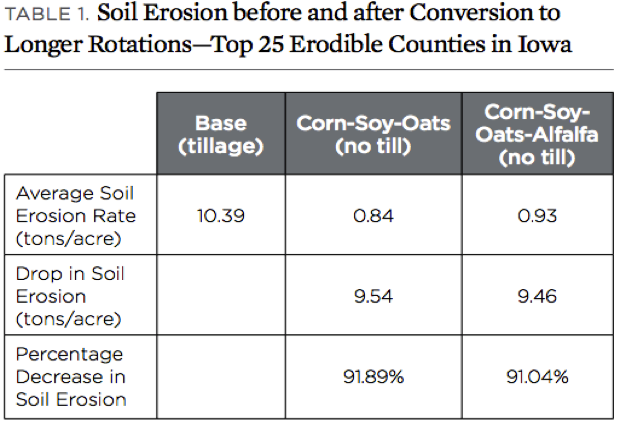
The conservation benefits of diversified crop rotations have long been known – from healthier soil and less erosion to fewer pests and better water retention, diversified rotations can help farmers address a multitude of environmental concerns. A new report by the Union of Concerned Scientists (UCS), a National Sustainable Agriculture Coalition (NSAC) member organization, highlights how these rotations can also increase yields and reduce the amount of money farmers have to spend on inputs.
UCS’ report, Rotating Crops, Turning Profits: How Diversified Farming Systems Can Help Farmers While Protecting Soil and Preventing Pollution (Rotating Crops, Turning Profits), details the impacts of on-farm diversification, the barriers to making the transition from a two-crop rotation to a more diversified rotation, and the ways in which policy can remove these barriers. Diverse crop systems, simply put, are those that include three or more crops in a rotation, rather than the usual one or two. Rotating Crops, Turning Profits builds onto an experiment led by Iowa State University (the “Marsden Farm Study”) that studied the combined effects of a diverse, no-till crop system on a farm’s yield and profitability. Taking this one step further, Rotating Crops, Turning Profits digs into the implications of a diversified system, not just on the farm, but for downstream communities and Iowa as a whole.
The findings and analysis from the Marsden Farm Study and the Rotating Crops, Turning Profits report are particularly salient given the downturn that has defined much of the American farm economy in recent years. Over the past four years, net farm income has declined by nearly fifty percent, largely due to low commodity prices of major crops like corn and soy. As the report points out, conservation farming practices and diversified crop plantings are key components of rebuilding a healthy farm economy that is able to remain viable during times of low commodity prices. Programs that encourage and reward these practices will be key priorities for NSAC and our members in the upcoming 2018 Farm Bill. This post will dig into some of the major highlights of UCS’ analyses, but to read the full report, click here.
The Marsden Farm Study
Iowa State’s Marsden Farm study was conducted in the ideal testing ground – the middle of the “corn belt,” the 12 state area of agriculture that dominates the Midwestern landscape. Corn and soybeans make up a whopping 70 percent of planted acres in these states. Many of the farms in this region have failed to adequately limit soil and nutrient loss from their farms, leading to water pollution and the creation of a “dead zone” in the Gulf of Mexico.
Beginning in 2003, Iowa State endeavored to quantify the benefits of crop diversification as a way to encourage better environmental practices while not adversely affecting farm incomes. Researchers tested three variations of diversified systems, including one with planted oats and alfalfa (which can replace corn and soy as feed ingredients). Additionally, the experiment adjusted fertilizer and till versus no till farming methods to further differentiate outcomes. The three test plots included:
- Traditional two-year soybean and corn rotation, using synthetic fertilizer only;
- Three-year crop rotation of corn, soy, and oats, a small grain that can grow in cooler months, with the addition of clover as a cover crop and no-till, using a combination of cattle manure and synthetic fertilizer; and
- A four-year crop rotation of corn, soy, oats, and alfalfa, using no-till and a combination of cattle manure and synthetic fertilizer.
The study revealed that multiple-crop rotations provided significant benefits to a farm’s productivity and input expenditures. Among the key findings, the major highlights included:
- Higher yields: corn yields were 2 to 4 percent higher per acre and soybean yields were 10 to 17 percent higher per acre.
- Profit remained similar such that revenue generated was statistically similar across the three variations.
- Herbicide usage reduced by up to 51 percent, reducing nutrient loss by 81 to 96 percent.
- Synthetic nitrogen pesticide usage reduced by 88 to 92 percent; organic pesticide use was reduced by 43 to 57 percent.
UCS Analyses: Digging Deeper
While the Marsden Farm study highlighted the direct benefits of diversification to farm income and local ecology, UCS’ analysis outlines how these changes might be felt state-wide. The report begins with a single hypothesis: adopting diverse rotation systems on Iowa’s most erodible soils will produce dramatic benefits for a farm, downstream communities, and the environment.
To test their hypothesis, UCS isolated Iowa’s top 25 most erodible soil areas, taken from the top 25 percent most erosive watershed districts in the state (importantly, UCS also found that most soils in Iowa, not just these top 25 counties, averaged loss rates above tolerable soil loss levels, as defined by the U.S. Department of Agriculture). Based on Iowa State University’s Daily Erosion Project Model, UCS was able to gauge the benefits that might arise from corn-soy-oat and corn-soy-oat-alfalfa crop rotations.
Using an economic model, the report then analyzed the economic impacts of diversification for the entire state of Iowa and the extent that diversification would be viable state-wide. Specifically, the report sought to establish the number of acres that could transition to a longer rotational scheme without negatively affecting farmers’ yield or revenue.
Scaling Up, Statewide Impacts
UCS first analyzed what diversification would mean for Iowa’s most erodible soils (15 percent of all Iowa cropland). As Table 1 shows, both the no till corn-soy-oats and the no till corn-soy-oats-alfalfa rotations could decrease soil erosion by over 91 percent, from 10.39 tons per acre every year to less than one ton per acre every year.

In addition to reducing soil erosion, UCS found that these multiple-crop rotations would lead to reduced fertilizer runoff, protecting and improving overall water quality while also saving the downstream community millions of dollars in surface water clean up costs. Similarly, the minimal use of synthetic nitrogen-based fertilizer in these systems (which rely more heavily on cattle manure and cover crops), were found to significantly reduce greenhouse gas emissions.
But to what degree would it be possible to expand these sustainable farming practices to the rest of the state? The report estimates that between 5 million and 11 million acres of Iowa cropland could be sustainably diversified (i.e., diversified in such a way that farmers could maintain the new systems and not feel pressure to revert to the traditional two-crop rotation). Note that under this scenario the report assumes that the remaining cropland would continue under traditional planting schemes. A summary of UCS’ conclusions follows:
- Diversified crop rotations could be applied on 20 – 40 percent of acres over time without farmers returning to corn-soy rotations because of demand.
- No-till production methods would reduce soil erosion by about 88 percent as compared to a traditional, tilled corn-soy production system.
- Reduced soil erosion would mean less watershed contamination. The study estimated that regional taxpayers could save up to $272 million in water cleanup costs.
- The combined benefit to society of both limiting greenhouse gas emissions by reducing fertilizer usage and increasing soil carbon sequestration could save over $200 million annually for society as a whole.
Diversified Farming in the Context of the 2018 Farm Bill
Despite the many benefits of switching to a diversified crop rotation, many farmers are still hesitant or unable to make such a transition. As part of our 2018 Farm Bill work NSAC is committed to making these agro-ecological approaches more accessible and practical for all farmers. To read more about NSAC’s 2018 Farm Bill campaign priorities check out our farm bill blog series.
One key way in which the farm bill can protect and uphold diversified, sustainable farming systems is through advancing working lands stewardship and comprehensive conservation. NSAC’s priorities in the 2018 Farm Bill include enhanced support for USDA programs that help farmers implement and enhance conservation systems. The Conservation Stewardship Program (CSP), for example, provides support to farmers to install and improve resource-conserving crop rotations, among other conservation activities. As the farm bill debate progresses, we will continue to look for opportunities to support diversification through conservation, research, marketing, and other farm bill programs.
To read the full UCS report, click here; and to read their associated blog post, click here.

